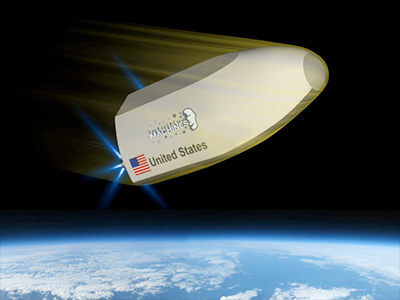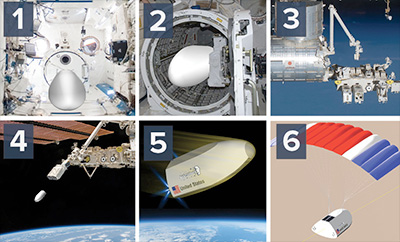Science Sample Return Vehicle for International Space Station National LaboratoryIntuitive Machines in cooperation with National Aeronautics and Space Administration (NASA) has been selected by the Center for the Advancement of Science in Space (CASIS) to develop a Terrestrial Return Vehicle (TRV) that will enable on demand, rapid return of experiments from the International Space Station (ISS) National Laboratory.
Through this commercial service, Intuitive Machines will enable researchers to regularly and quickly return small samples and components from the ISS to Earth. The timely delivery of critical or perishable samples is essential in enabling new and exciting research aboard the ISS National Laboratory.

Currently, retrieval and return of experiment results from the ISS are restricted to only a couple of times per year and requires a lengthy upfront planning process. In contrast, the performance of Intuitive Machines' TRV allows for frequent delivery opportunities with same day delivery of samples from ISS to the researcher's laboratory. Intuitive Machines will provide this service to a wide range of customers including scientific, academic, commercial, and government.
This new capability will enable increased utilization of the ISS as a national laboratory and improve the commercialization opportunities of experiments for terrestrial benefit. The first flight of the TRV from the ISS is planned for 2016.
"The International Space Station, with its unique microgravity laboratories and crew, enables research over a wide range of disciplines from physics through biology. This small payload return capability will provide controlled conditions and flexible choices for timely sample analysis. The scientific team will be able to much more efficiently adjust experimental parameters in response to results, exploit unique results, and correct problems encountered." said Dr. David Wolf, a research scientist and former astronaut.
As part of this new venture Intuitive Machines is responsible for the overall design and certification of the return vehicle, as well as terrestrial payload return services for its customers. CASIS will provide integration onto a commercial launch vehicle for access to the ISS, as well as on-orbit flight operations services.

Terrestrial Return Vehicle:
- The TRV is delivered to ISS on a commercial resupply service vehicle and stored on orbit until needed
- Once the transfer cargo is loaded into the TRV it is placed into the Japanese Experiment Module (JEM) airlock
- The JEM Robotic Manipulator System extracts the TRV
- Once the jettison attitude is achieved the TRV is released
- At the appropriate time a deorbit maneuver is initiated
- Airfoil is deployed and TRV gently lands at the designated spaceport
The TRV is designed to be stored in the habitable volume of the ISS and deployed on demand from the Japanese Experiment Module (JEM) airlock via the Cyclops ejection mechanism with assistance from the JEM Robotic Manipulator System. The vehicle is equipped with propulsion and flight control systems, which perform the propulsive maneuver for de-orbit, guided entry, and descent through the Earth's atmosphere. The lift-to-drag ratio of the TRV airframe enables superior range and cross range capability compared to a capsule and thus, more landing opportunities with a reduced entry g-load.
It contains all of the necessary subsystems for protecting the payload during the return and delivering it accurately to a landing location such as a dry lakebed, where it can be readily retrieved. Once recovered, the payload will be removed from the TRV and delivered to the customer.













